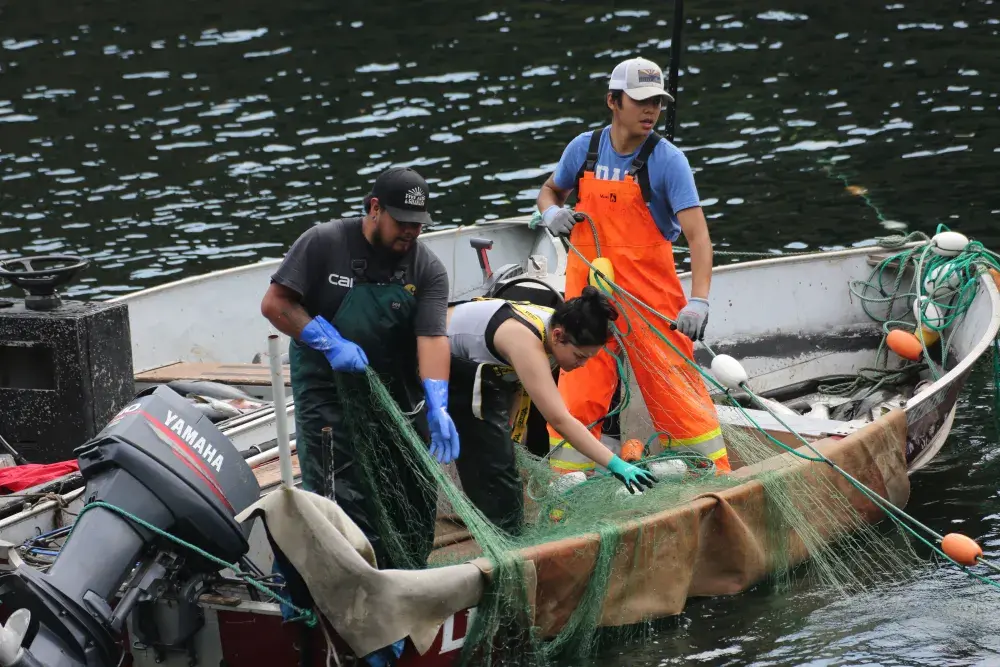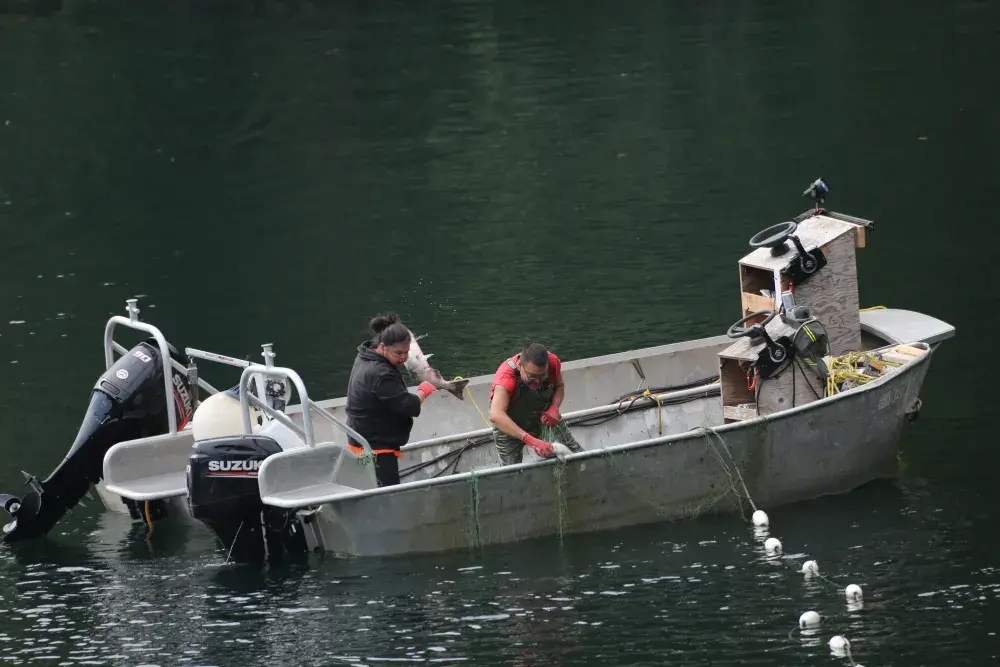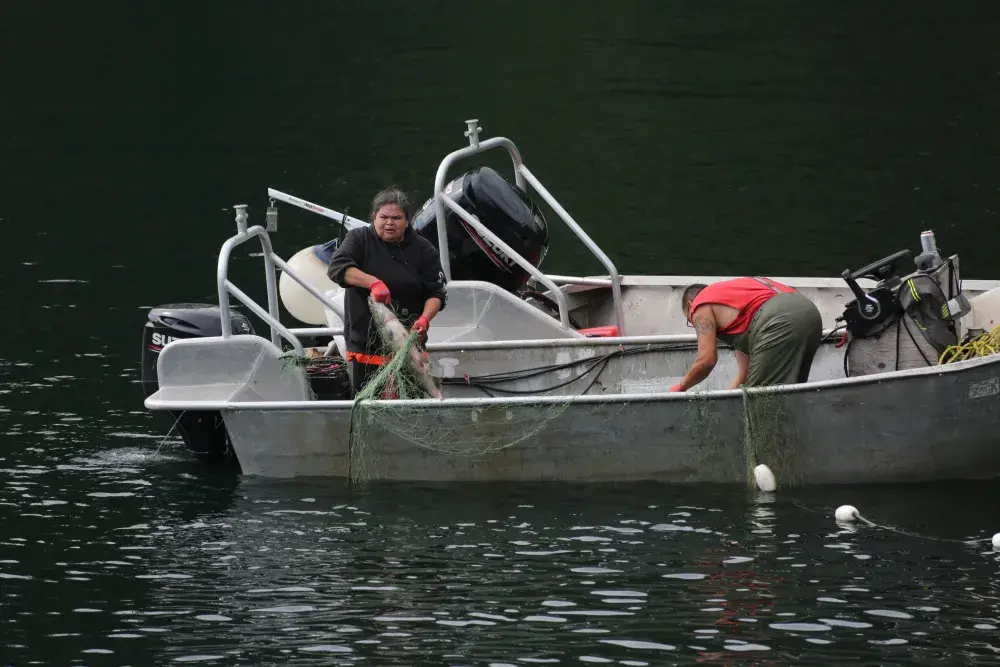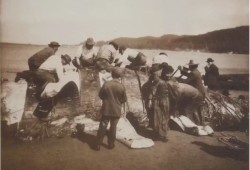Prior to colonization, Nuu-chah-nulth diets were known to consist of whale, seal, and salmon. Since contact, traditional diets have shifted to adapt to fishing and hunting regulations, but still, traditional aspects of acquiring food persisted.
“What you would see as a traditional diet we had… previous to colonization, we'll never see that again,” said Dr. Charlotte Coté of the Tseshaht First Nation, who is a professor at the University of Washington specializing in food sovereignty. “It’s impossible.”
“We don't have the same environment as pre-contact to sustain ourselves that way,” she added. “That doesn't mean we can't have traditional foods in our diet, but we have to complement those diets with other foods.”
“Whale was a prominent feature in traditional Nuu-chah-nulth diet, as well as seal and then, of course, other fish and seafood,” said Rachel Dickens, who is Ts’msyen of the Lax Kw’alaams First Nation, and a dietitian for the Nuu-chah-nulth Tribal Council. “Primarily whale - and using the whole animal, not just the meat, but also the blubber.”
She shared that other aspects of the traditional diet consisted of berries, crab apples, seagull eggs and root vegetables, as well as gamey meats such as duck and deer.
But with government policies and the over harvesting of certain species, First Nations people experience restrictions in their traditional practices, shared Dickens.
“That kind of created this break in knowledge around how to hunt whales and all the spiritual traditions, practices and rituals that went around a whale harvest,” said Dickens, adding that the same could be said for seals, as overhunting led to a ban on harvesting the animal.
In early March, Dickens was involved in a diabetes wellness retreat with Ahousaht First Nation, where a group of Ahousaht elders processed a seal, sharing stories of their parents and grandparents who once undertook the same practice.
“We weren't just eating the seal, we were sharing stories, and also processing the blubber to make seal oil, and then had a seal feast,” said Dickens.
Though seal hunting and processing is not practiced on as wide of a scale as salmon fishing or clam harvesting, it is still being done, said Dickens. When it is practiced, it is largely celebrated, she added.
“Throughout my lifetime, I've really maintained, or really attempted to maintain, a diet that included traditional foods,” shared Coté. “I grew up in the berry picking tradition, I grew up in the salmon harvesting tradition, [and] I still fish for salmon when I come home every summer.”
“You can't talk about a traditional food without talking about salmon, especially with Tseshaht,” Coté added. “Salmon is part of our cultural identity.”
What Coté now considers a traditional meal would include salmon paired with rice, soya sauce, boiled potato, or green onion, she shared.
“Those aren't traditional to our diets, but they become part of what we consider a traditional meal,” said Coté.
“Our traditions have always changed, they're dynamic, they're fluid, they're not static,” she continued. “As part of that fluidity, I think incorporating healthy foods into our diets, but keeping or trying to keep traditional foods at the heart of it, is really what we're striving for today.”
But with the expansion of the global industrial food system people are at risk of lifestyle illnesses such as cardiovascular disease, diabetes, cancer, and autoimmune disease, shared Coté, who sees a rise in these conditions throughout her community.
For the Indigenous people of Canada, discussions about health and wellness must consider the impacts the residential school system, said Coté.
“The major goal was assimilation, to assimilate our young children, the heart of our communities, into the larger mainstream society,” said Coté. “But also, to weaken their relationships with their own cultures, traditions, languages, and foods.”
“The boarding school really shifted that relationship we had with food,” she said.
Starting in 1891, Alberni Indian Residential School (AIRS) operated on the Tseshaht reserve, closing its doors officially in 1973.
“Children did not eat traditional foods there, they ate a very highly processed diet, a very inadequate diet and a very unhealthy diet,” added Coté. “Many of our people suffered as a result.”
“It doesn't mean if you're not attending those schools anymore, you just naturally learn how to be healthy,” she said.
Coté reflected on the Tseshaht Community Garden, led by her sister, Gail Gus, who began growing vegetables, fruit, flowers and herbs for their community in a garden located behind one of the remaining former AIRS buildings.
“It's not traditional foods, but it's healthy foods,” said Coté, who was excited to hear about the project.
The garden became part of a greater movement within the community, where Gus would share healthy recipes and teach harvesting, cooking and canning lessons, shared Coté.
Gus, alongside other knowledge holders, were reintroducing that information to people in the community who never had access to it, she added.
“Because they came from generations of boarding school and that knowledge hadn't been passed down,” said Coté.
When the Tseshaht First Nation began its research and scanning for unmarked graves at the location of the former AIRS buildings, the garden was removed. Gus shared with Ha-Shilth-Sa that she is currently working on relocating the garden to the side of the Tseshaht Youth Centre.
For Coté, re-Indigenizing diets is at the heart of a decades-long movement for cultural resurgence and self-determination.
“The food sovereignty movement really began to be positioned within these larger struggles, anti-colonial struggles, decolonization struggles,” said Coté, “to have more authority and control over our homelands, over our bodies, over our diets and over the foods that we can eat.”
“Bringing back these foods, re-engaging with our environment in a very sacred way, in a very cultural way, and in a very respectful way, was really at the heart of that,” she said.
“[With] traditional food harvesting and consumption, the practice is still there,” said Dickens. “There have been some blockages because of all these government restrictions, the residential school system, the loss of knowledge translation, but the practices are still there.”
“Nuu-chah-nulth people are bringing it back with a lot of strength,” she added.




